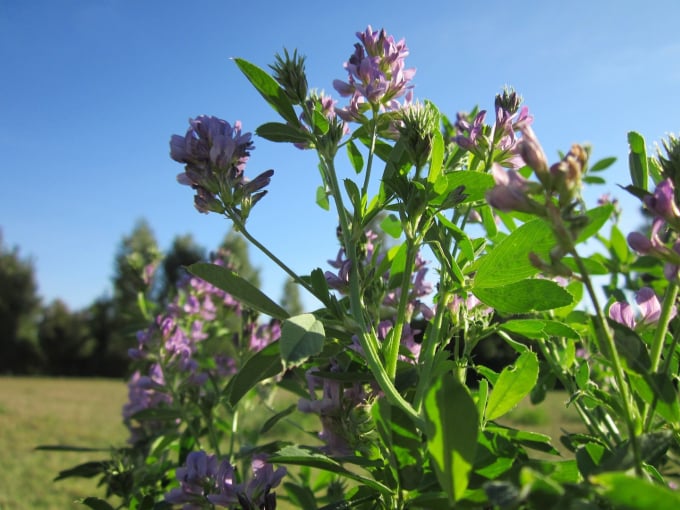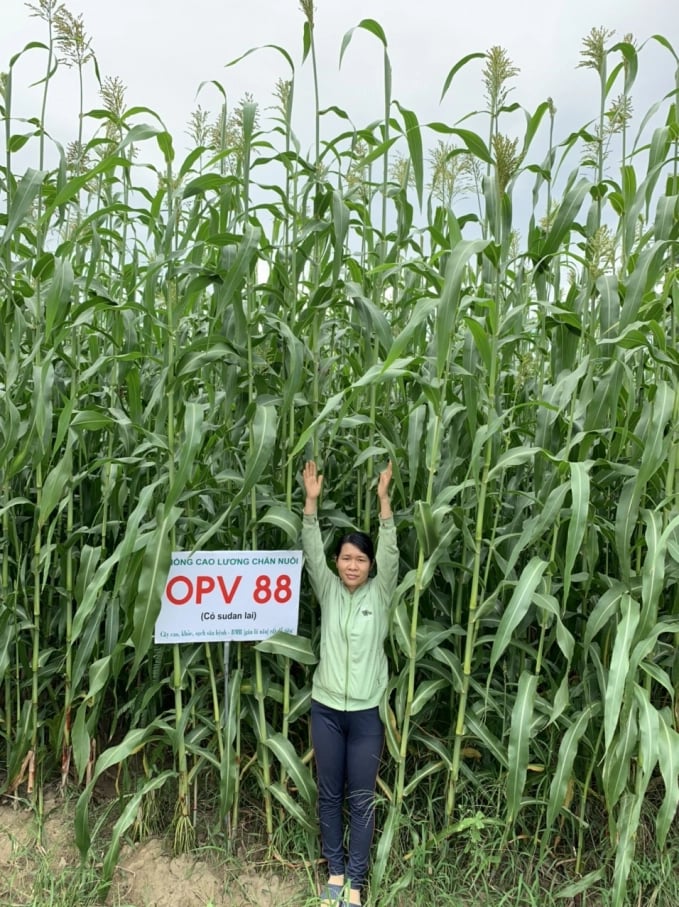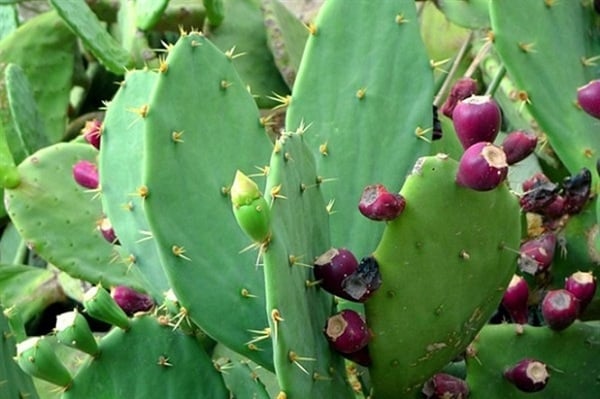May 30, 2025 | 17:22 GMT +7
May 30, 2025 | 17:22 GMT +7
Hotline: 0913.378.918
May 30, 2025 | 17:22 GMT +7
Hotline: 0913.378.918
Objectively speaking, Vietnam already has little advantage in the production of grain materials used in animal husbandry, but the almost-complete dependence on imported raw materials has caused the industry to lose its competitiveness, wasting the potential of the development of animal feeds.
According to the Vietnam Academy of Agricultural Sciences (VAAS), alfalfa is the second highest protein plant after soybean with a protein content of 18-23%. It is a forage suitable for many kinds of livestock specifically dairy and fattening cattle. It is widely used by many countries around the world, mainly processed as valuable feed for poultry and fish.

Alfalfa’s protein content is 18-23%, the second highest after soybean.
Alfalfa is a highly cold-tolerant plant suitable to be developed in ecological zones such as the northern mountain land - where livestock are in high demand of nutritious feed in winter. Its average yield ranges from 16 to 20 tons/ha/harvest, or 25 to 30 tons/ha/harvest with intensive farming, and it can be harvested 5 - 6 times per year. This affirms its advantage as a potential animal feed.
A number of alfalfa varieties have been imported, collected and evaluated. Among the 60 samples of alfalfa varieties, the AF1 is selected. The current cultivation technique gives yields exceeding 60 tons/ha/year, and the three promising varieties AF2, AF3, AF4 show good growth ability in consideration of the autumn-winter or winter-spring crop.
But what limits the development of alfalfa in Vietnam is that we have not mastered the domestic seed production as well as the harvesting and post-harvest technology especially the drying technology for long-term preservation.
Wheat and barley were once grown in the North of our country while having good growth and development, but the area was not large due to farmers’ cultivation level and farming habits.
Wheat and barley are now widely used as a source of starch in animal feed processing and food and beverage making. Every year Vietnam has to import 100% of wheat with approximately 665 thousand tons (2020) only used for food processing purposes.

Dr. Nguyen The Hung (Faculty of Agronomy, Vietnam National University of Agriculture) inspecting a wheat field in Mu Cang Chai district, Yen Bai province (April 2017). Photo: Le Ben.
These two plants have high resistance to cold and drought, suitable for growing in winter crops in the Red River Delta and the Northern Midlands and Mountains to increase adaptability in arid soils and lands suffering from climate change.
With an output of 2.5 - 3.5 tons of grain and 30-40 tons of by-products per ha in cold and drought areas, wheat and barley have the potential to develop as valuable raw materials for animal feed processing, contributing to reducing the pressure due to import from other countries in the world.
Sorghum has the same cultivation characteristics and requirements as maize but has yields of 2-3 times higher, not to mention its ability to regenerate for the second time. The downside is that it has lower nutrition quality than maize. This plant can also grow well in Vietnam considering our country's climatic conditions.

Nhaho Research Institute for Cotton and Agricultural Development has researched, tested and selected specialized sorghum varieties to serve animal husbandry.
Sorghum used to be planted scatteredly in the South Central provinces, but its seeds were mainly used to serve poultry raising instead of utilizing biomass for animal feed processing. In the last two years, with the gradual shift to farm-scale husbandry in the South Central provinces, the area planted with sweet sorghum for animal feed has gradually expanded.
It is expected that sorghum will be expanded and developed strongly in the coming time as a source of material for animal feed since the Ministry of Science and Technology has approved a program to research and develop sorghum in Phu Yen in 2021.
Oat is also considered a good cold-tolerant plant, capable of growing in the autumn-winter/winter crop in the Red River Delta and the Northern Midlands and Mountains. The yield can reach 45-60 tons/ha, and it can be harvested 2 times per year.
Oats are only grown mainly in Moc Chau (Son La) with a modest scale at the moment, but they can be fully developed and expanded to provide forage in the winter crop in those areas - a very important time in the winter when there is a shortage of forage for livestock.
Nopal cactus (genus Opuntia, Cactaceae family) grows well in arid (rainfall below 250 mm/year), semi-arid (precipitation from 250 - 450 mm/year) years), or nutrient-poor soils. It is a plant with many benefits. Its fruit and stem can be used for many different purposes, bringing many practical uses.

The Nopal cactus holds great environmental significance - a plant that can well-served the demand of the animal husbandry industry.
In terms of livestock raising, the Nopal cactus stem segments are succulent and rich in minerals and vitamins. They can be used as a fresh ingredient for direct feeding or processed into different types of dry food such as chopped and dried, ground into powder, or silage.
However, research and development of Nopal cactus varieties for use as animal feed are only staying at the level of testing at the moment, not mass development in production.
Recently grass varieties such as Mulato II, Ruzi, guinea grass, and para grass are growing in popularity in the South Central provinces, but are still on a small scale and cultivated using semi-intensive methods, so the efficiency is not high. But with the current development of animal husbandry, the planting area of these grasses has begun to expand.
Having the livestock farm structure gradually shifted to the South Central provinces and the Central Highlands, it is prognosticated that the development of these grass varieties will increase sharply in the near future.
Translated by Samuel Pham

(VAN) Several scientists and farmers are experimenting with soil treatment in some key durian-growing regions such as Cai Lay (Tien Giang), Dak Song, Gia Nghia, and Dak R’lap (Dak Nong).
/2025/05/25/4127-3-073637_820.jpg)
(VAN) Thanks to the promotion from an FAO-implemented project, vegetable production in greenhouses in Moc Chau has seen strong development, from 1.5 hectares in 2021 to nearly 50 hectares in 2024.

(VAN) FAO has recently supported USD 140,000 to implement the project 'Risk mitigation human-animal interface risks through disease control initiatives in pig farming.'

(VAN) The People's Committee of Tra Vinh province has approved an adjustment to the investment policy for the Green Hydrogen Plant project, increasing its area to approximately 52.76 hectares.
![Reducing emissions from rice fields: [2] Farmers’ commitment to the soil](https://t.ex-cdn.com/nongnghiepmoitruong.vn/608w/files/news/2025/05/05/dsc08881jpg-nongnghiep-140632.jpg)
(VAN) Clean rice cultivation model in Thuong Tan commune, Bac Tan Uyen district, is assisting local residents in achieving sustainable agriculture by substantially reducing costs, increasing productivity, and protecting the environment.

(VAN) At the conference to disseminate Resolution No. 68, AgriS introduced its digital agricultural ecosystem and reaffirmed its commitment to accompanying the Government in promoting private sector development and sustainable agriculture.

(VAN) 'Blue Ocean - Blue Foods' initiative is designed to restore marine ecosystems and establish sustainable livelihoods for local communities by cultivating a minimum of 1,000 hectares of cottonii seaweed in the first three years.